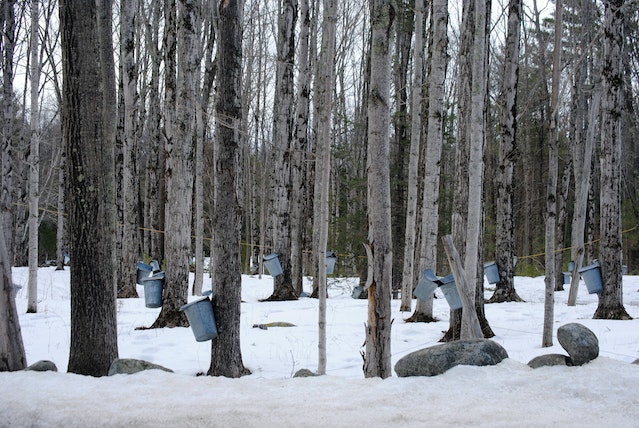
How much maple tree sap do you need to make 1 liter of maple syrup? It takes about 40 liters of sap to make 1 liter of maple syrup.
Maple syrup is made by taking the sap from sugar maple, black maple, or red maple trees. The trees are tapped when they are about 30 years old and a single maple tree can produce about 50 liters of sap per season. That means, basically, you need one maple tree to make one liter of maple syrup in one season. In 2016, Canada produced 54,887,218 liters of maple syrup, which means they needed a lot of trees.
During the spring and summer, trees photosynthesize and create carbohydrates. They use this energy to grow, produce leaves, and repair themselves. The carbohydrates are stored in the tree as starch. These starches are converted into sugar and dissolved into the tree’s sap. By doing this, they can be transported all around the tree. In the autumn, when the temperature drops down to about 5 to 8˚C, the trees lose their leaves and the sugar filled sap is shunted down to the roots to be stored. It is converted back to starch. While the temperature stays below about 4℃, the starch remains stored in the tree roots. The tree stays this way through the winter.
Once the temperature rises above 4℃ in the spring, enzymes in the tree change the starch back into sucrose, which combines with water from the roots and flows up through the tree. The tree uses this sugar store to grow new leaves in the spring. Maple syrup producers tap the trees in early spring when the temperature has just started to rise and before the tree can use its sap. They drill holes into the tree and collect the sap as it flows up. Maple trees are tapped for about 50 liters of sap every year, but this doesn’t appear to harm them. Maple trees that are tapped still live to be 100 years old and they grow at a similar rate to other trees.
So, how do you make maple syrup? A hole is drilled in a tree and the maple syrup pours out of the hole. In traditional methods, a bucket is hung on the tap and the syrup pours into the bucket. In modern maple syrup production, plastic tubes are attached to the tree and vacuum pumps suck the sap out to speed up the process. Once the sap has been removed, it has to be boiled. Even though maple syrup trees have a lot of sugar, their sap is still only about 2 to 5%. Boiling the sap reduces the water content and increases its sweetness. The sap has a very high water content, which is why it takes 40 liters of sap to make 1 liter of maple syrup. Once it has been boiled down, it is bottled and shipped.
The maple tapping season varies in length year by year, depending on the temperature. Once the temperature gets too warm, there is an increase in amino acids in the sap and it starts to taste bad. Generally, the maple tapping season lasts four to six weeks. The huge maple syrup companies have to produce all of those 55 million liters in just those four to six weeks.
Many different trees can be tapped to make a syrup, but the maple is the most common. Palm trees produce a sweet sap that is boiled down to make palm sugar. Sycamore sap produces a syrup that tastes of butterscotch. Nearly all trees produce sap, but many of them have a lower sugar content than maple, or they don’t taste as good.
The indigenous peoples in North America discovered maple syrup long ago. They cut a V-shaped incision in the tree and used reeds to tap the sap. They collected it in clay buckets which they heated over a fire to concentrate the syrup. The indigenous people taught the European colonists how to get sap out of the trees. The Europeans started to drill holes in the trees to tap them. Until about 1850, maple syrup was boiled down to a sugar because it was cheaper than sugar imported from the West Indies. After 1850, sugar became much cheaper and maple syrup producers started making and selling maple syrup. Over the next century and a half maple syrup production has evolved dramatically. Nowadays, the sap is sucked from the trees along a pipe to a central evaporator house where boiling times are much shorter than they used to be. Producers are also experimenting to see if they can produce sap from young trees as well, which will increase the amount of sap they can produce every year. So, next time your pour maple syrup on your pancakes, spare a thought for the tree it has come from. And that is what I learned today.
Sources
https://employees.csbsju.edu/ssaupe/biol327/Lab/maple/maple-sap.htm
https://en.wikipedia.org/wiki/Maple_syrup
https://en.wikipedia.org/wiki/Sap
https://wonderopolis.org/wonder/how-do-trees-make-sap
https://www.ehow.com/facts_7873563_do-maple-trees-produce-sap.html
https://www.portland.gov/trees/get-involved/news/2021/3/30/tree-physiology-primer-all-about-roots
